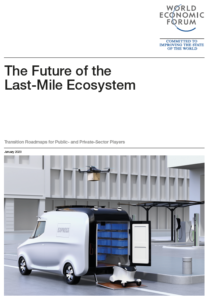Growing demand for e-commerce delivery will result in 36% more delivery vehicles in inner cities by 2030, leading to a rise in both emissions and traffic congestion without effective intervention. Without effective intervention, urban last-mile delivery emissions and traffic congestion are on track to increase by over 30% in the top 100 cities globally.
The World Economic Forum report Future of the Last-Mile Ecosystem analyses interventions that can reduce emissions, congestion and delivery costs for the urban last-mile. With the ecosystem-wide change, interventions could reduce emissions and traffic congestion by 30%, and delivery cost by 25%, compared to the “do-nothing” scenario.
Femke Halsema, Mayor of Amsterdam: “The city of Amsterdam is expected to have 1 million citizens in 2032, a growth of 20% compared to today. The number of jobs is expected to grow by 30% until 2040. The additional volume of traffic will lead to severe bottlenecks on the road and in public transport. Especially urban deliveries – mostly linked to the soaring e-commerce growth rates recently – cause structural problems to the city of Amsterdam. Currently, one in eight vehicles in the inner city is a truck or a van. Many old bridges and quays are not designed for heavy loads and intensive use these days. Also, delivery vans cause gridlock, as these vehicles park on the street or in busy inner-city areas. Also, they present a safety risk to our many bike users and pedestrians. To combat this development and achieve our decarbonization targets, we have put a plan in place according to which the inner city will be free of fossil-fuelled trucks and vans by 2025, causing a 77% reduction in NO2, and a 42% reduction in CO2 from all of the traffic in the city, including passenger cars.”
To counteract this development, numerous interventions could be considered. The WEF report assesses 24 supply chain and technology interventions in terms of increased traffic volume, CO2 emissions, congestion, delivery cost, investment need and qualitative dimensions such as customer convenience and level of competitive disruption. Also, WEF wants to start a discussion on how these interventions could best be combined, taking into consideration potential cannibalization or synergy effects.
Recommendations to ecosystem players
Something needs to happen. But where to begin? We present three different transition roadmaps and argue that an integrated ecosystem approach would optimize the last mile for both private and public players while minimizing customer disruption. This scenario includes electric vehicle regulation for inner-city areas, deliveries during night-time and before/after working hours, effective data-based connectivity solutions such as dynamic re-routing and load-pooling, as well as multi-brand parcel lockers and boxes. Such a scenario could reduce CO2 emissions by 30%, congestion by 30% and delivery costs by 25% by 2030 when compared to a “do nothing” baseline.
In addition, WEF also presents a high-level timeline to indicate which interventions already have the potential to become effective in the next few years. In terms of next steps, they encourage private and public players to team up and accelerate the roll-out of pilots on the suggested interventions. Also, they believe there is tremendous value in building discussion networks or consortiums for cities to exchange the most effective methodologies, discuss challenges and liaise with private-sector players. Besides, they believe that robust, harmonized regulations – e.g. for autonomous driving and inner-city e-mobility – would help automotive OEMs and logistics players to better allocate R&D investment and accelerate the adoption of sustainable supply-chain technologies.
Lastly, the use of data and advanced analytics is a vital enabler for interventions such as effective load-pooling and real-time traffic control. Also, joint data standards and effective data sharing can bring tremendous benefits to all ecosystem players.


The team and myself at Infinium Logistics Solutions have been assessing these types of service opportunities globally over the past 12 months or so.
We have been working with global car park operators who often have real estate in perfect locations to operate as logistics hubs and many have spare capacity; especially at night.
I can envisage vibrant, technology-enabled, ecosystems which offer a range of ‘non-car parking’ services including some of the following: parcel consolidation; storage units; PUDOs; lockers and micro-hubs.
It is all about getting closer to the customer, reducing delivery vehicles, easing congestion and reducing emissions. We are focusing on the demands of ecommerce and the changing dynamics of the final mile, linked to the changing habits of consumers.
An excellent report and article.